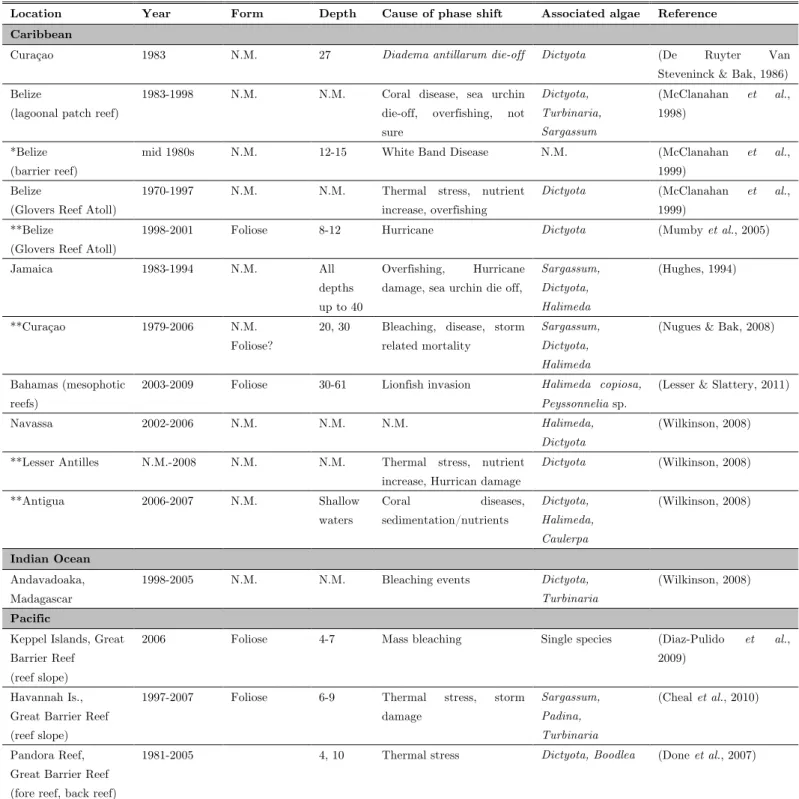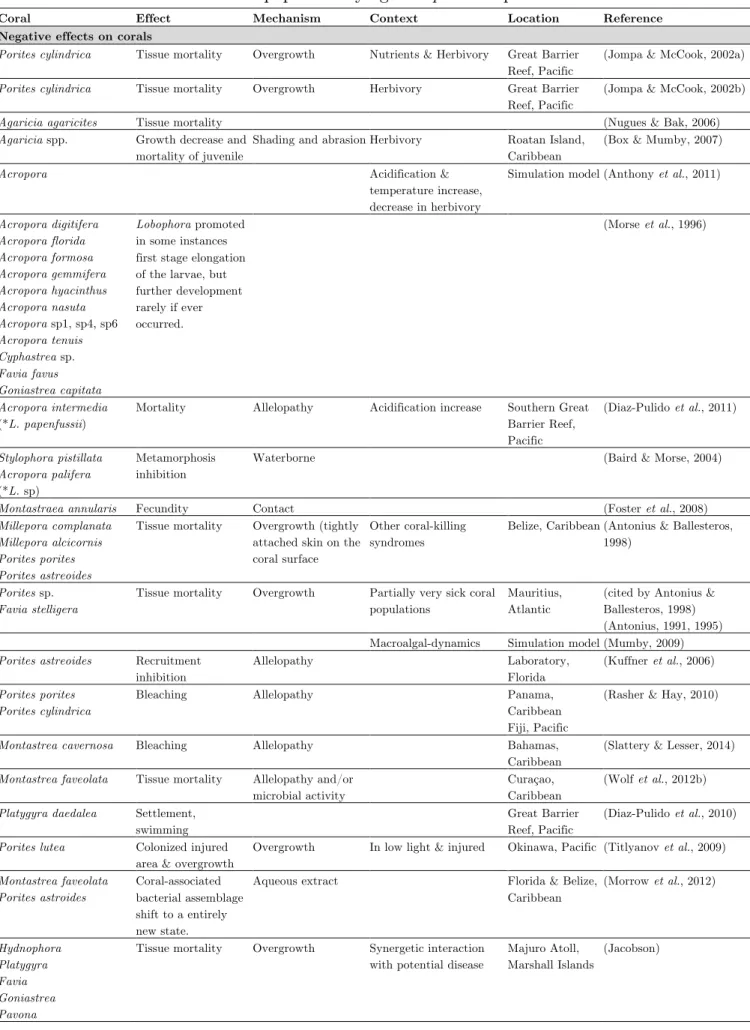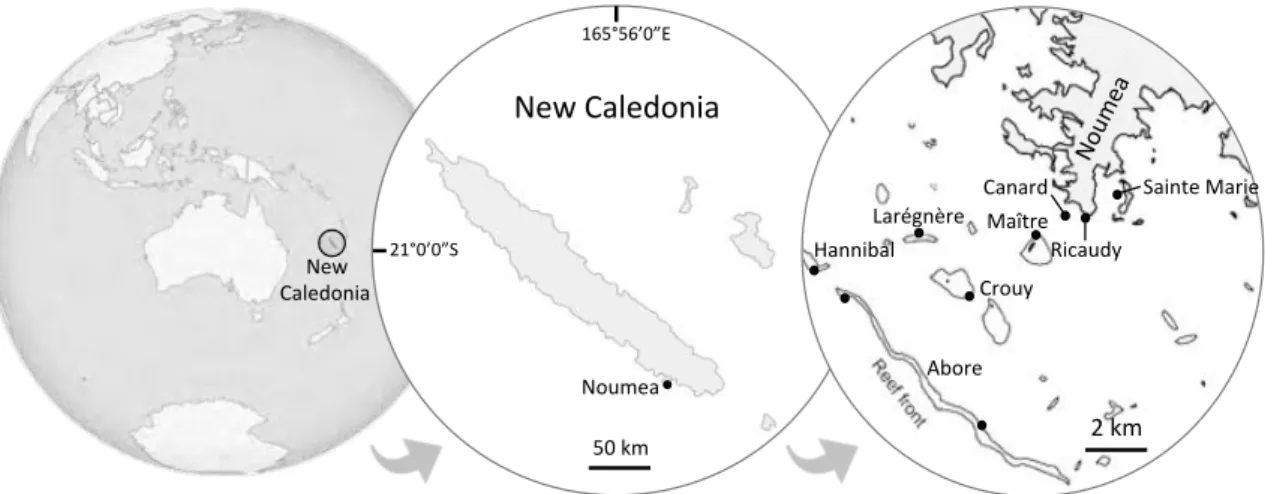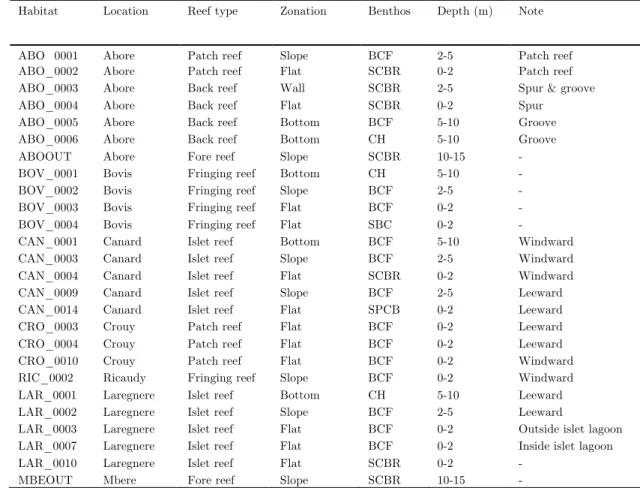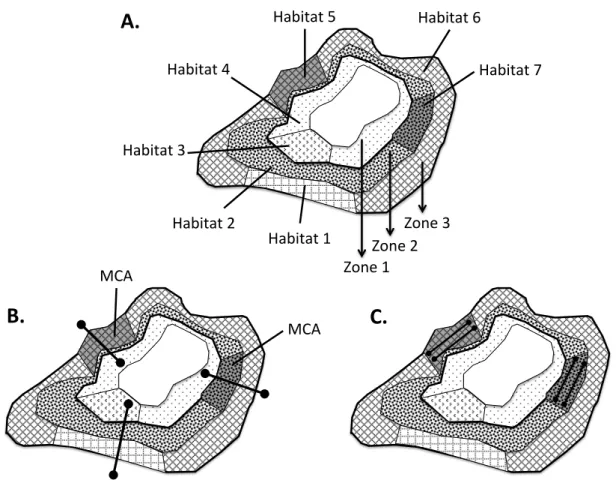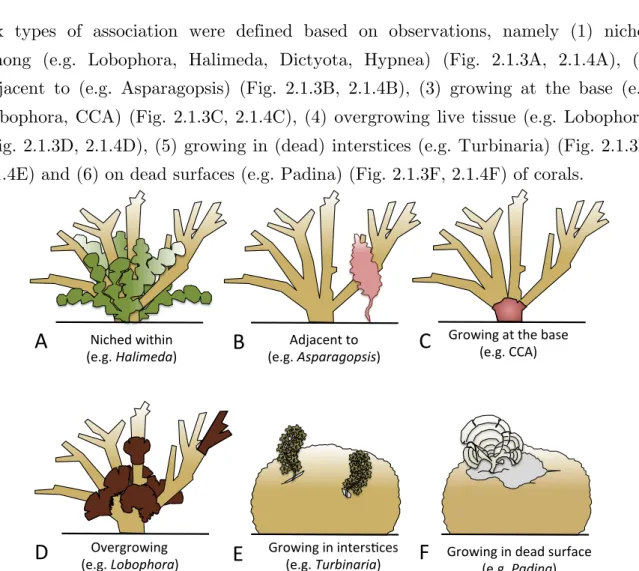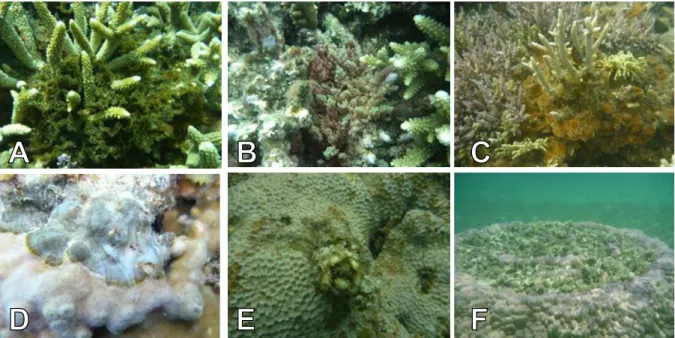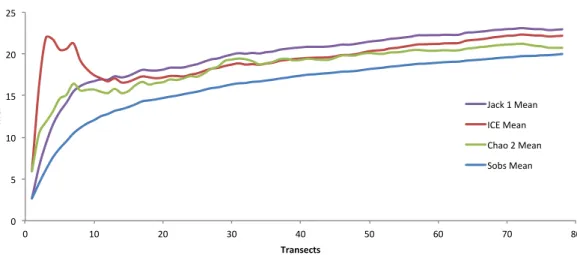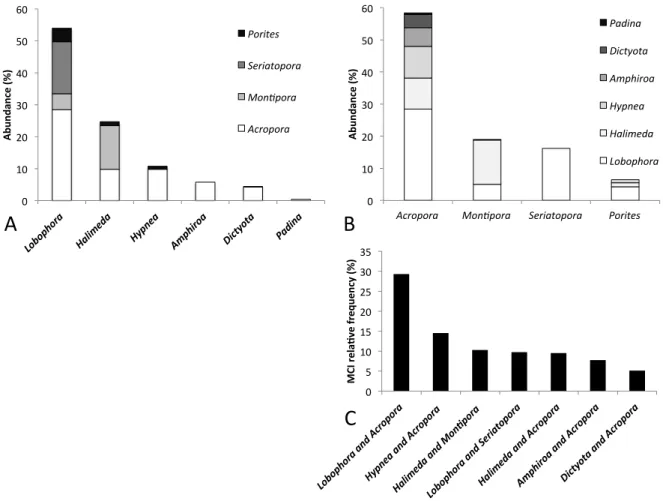HAL Id: tel-01252670
https://hal.ird.fr/tel-01252670
Submitted on 7 Jan 2016
HAL is a multi-disciplinary open access archive for the deposit and dissemination of sci-entific research documents, whether they are pub-lished or not. The documents may come from teaching and research institutions in France or abroad, or from public or private research centers.
L’archive ouverte pluridisciplinaire HAL, est destinée au dépôt et à la diffusion de documents scientifiques de niveau recherche, publiés ou non, émanant des établissements d’enseignement et de recherche français ou étrangers, des laboratoires publics ou privés.
To cite this version:
Christophe Vieira. Lobophora: biotic interactions and diversification. Systematics, Phylogenetics and taxonomy. Université Pierre et Marie Curie (Paris, France); Ghent University (Gand, Belgique), 2015. English. �NNT : 2015PA066195�. �tel-01252670�
Université Pierre et Marie Curie
Ghent University
École doctorale des Sciences de l’Environnement (ED 129)
IRD Nouméa / UMR ENTROPIE & Ghent University / Phycological Research Group
Lobophora: biotic interactions and diversification
By
Christophe VIEIRA
PhD in Marine Biology
Supervised by Claude PAYRI and Olivier DE CLERCK
Presented and publicly defended on the 3rd of July 2015 Before a Jury composed of:
DESTOMBE, Christophe (Professor, CNRS) Representing UPMC NUGUES, Maggy (Associate Professor, CRIOBE) External examiner LE GALL, Line (Associate Professor, MNHN) External examiner THOMAS, Olivier (Professor, CNRS-InEE) External examiner CULIOLI, Gérald (Associate Professor, MAPIEM) External examiner
VINCX, Magda (Professor, MARBIOL) External examiner
PAYRI, Claude (Professor, IRD) Co-supervisor
Université Pierre et Marie Curie
Ghent University
École doctorale des Sciences de l’Environnement (ED 129)
IRD Nouméa / UMR ENTROPIE & Ghent University / Phycological Research Group
Interactions biologiques et diversification du
genre Lobophora
Par
Christophe VIEIRA
Thèse de doctorat de Biologie Marine
Dirigée par Claude PAYRI et Olivier DE CLERCK
Présentée et soutenue publiquement le 3 Juillet 2015 Devant un jury composé de :
DESTOMBE, Christophe (Professeur, CNRS) Examinateur
NUGUES, Maggy (Maître de conférence, CRIOBE) Rapporteur LE GALL, Line (Maître de conférence, MNHN) Rapporteur
THOMAS, Olivier (Professeur, CNRS-InEE) Examinateur
CULIOLI, Gérald (Maître de conférence, MAPIEM) Examinateur
VINCX, Magda (Professeur, MARBIOL) Examinateur
PAYRI, Claude (Professeur, IRD) Co-directeur de thèse
Acknowledgements
To my scientific parents
I will begin these acknowledgements by thanking my supervisors Claude Payri and Olivier De Clerck without whom this Doctoral journey would never have happened. I feel greatly indebted to both of them not only for giving me this tremendous opportunity to realize this PhD, but also and especially for the wonderful scientific mentors they have been to me. As I often heard stories of PhD students that have been abandoned to themselves, I feel I have been really fortunate. I truly consider them as my scientific parents!
To the technical and administrative staff, to my scientific peers & collaborators
A number of people have made valuable contributions. Also I greatly acknowledge the technical staff from IRD and UGent for their precious help: the IRD divers: Christophe Peignon, Gerard Mou-Tham, John Butscher; the IRD boat crew: Miguel Clarque, Philippe Naudin and Samuel Tereua; but also the Jack of all trades Joseph Baly; and a special thanks to Sofie D’hondt and Tine Verstraete from UGent who thought me the bases of molecular techniques. I would also like to thank IRD and UGent researchers for the fruitful discussions we had and for their valuable advices: Mehdi Adjeroud, Serge Andrefouet, Linda Dombrowsky, Cécile Fauvelot, Véronique Guillemard, Fanny Houlbreque, Frederik Leliart, Ricardo Rodolfo-Metalpa, Heroen Verbruggen and Laurent Vigliola. I would also like to thank the administrative staff of IRD and in particular Catherine Hartmann, Juliette Lelong, Emanuelle Raffy, Marie-Noëlle Segura, Christian Turmolle and Catherine Verleye; and of UGent, Anja Hondekyn, for their kindness and their assistance with all the maddening administrative work. I deeply acknowledge the numerous people with whom I have collaborated: Robert J. Anderson, John J. Bolton, Olga Camacho, Gérald Culioli, Suzanne Fredericq, Lydiane Mattio, Thibaud Moleana, Marta Sansón, Michael J. Wynne, Sun Zhongmin and Maya Zubia. I am grateful to Aqualagon’s owner, Frank Le Garrec, for letting me perform the grazing experiments in their fish farm, and to its crew, Renaud Condoya and Marie-Claude Qalue, for assisting us in the deployment of the experiments at the fish farm. I am very grateful to Olivier Thomas not only for letting me perform a major part of the chemical work
at his instituion but especially for our invaluable collaboration. I am also thankful to Marie-Aude Tribalat for her kindness and great help with the chemical work.
To my friends & colleagues
I thank my friends & fellow PhD & post-doc comrades and from IRD Nouméa, Elvan Ampou, Laure Barrabé, Laurent Bordez, Christophe Cléguer, Paul Coulerie, Marion Cuif, Julien Debreuil, Laury Dijoux, Simon Gensous, Daphné Grulois, Adrien Jacotot, Mohsen Kayal, Audrey Léopold, Sofia Motuhi, Christelle Paillon, Héloïse Rouze, Josina tiavouane, Sébastien Trape, Simon Van Wynsberge and from UGent, Kenny Bogaert, Samuel Bosch, Andrea Del Cortona, Agnieszka Lipinska, Van Tu Nguyen, Frédérique Steen, Lennert Tyberghein, for the long and inspiring talks.
To name a few I would like also to acknowledge Xavier Girard, J. Michael Hicks, Fabian Carriconde, Swen & Géraldine Bidau, Laurent & Mylène Millet, for your friendship and for the great moments we had together during these past four years. A very special thank goes to the friends from New Caledonia whom have been like family to my wife & I: Brice & Coralie, Joel & Yorita Lauvray, Laurent & Nadia Guy, Christophe & Christine Peignon and Yves & Evelyne.
To my family
My before final acknowledgments go to my family, in particular my parents, brothers and sister Edgar, Kévin and Bélinda, and my in laws Patricia, Hyo Shim and David, for their unwavering love, supports and encouragements throughout these years.
To my wife
Last, but certainly not least, I would like to extend my heartfelt gratitude to the most precious person in my life, my wife, Sumi. Thanks to her love, patience, support and unwavering belief in me, I have been able to complete this long doctoral journey.
Christophe VIEIRA was granted by UPMC (ED 129) as part of the MARES programme. MARES is a joint Doctorate programme selected under Erasmus Mundus coordinated by Ghent University (FPA 2011-0016). Check www.mares-eu.org for extra information. During his PhD, CV has shared his time between IRD Nouméa and Ghent University with part of his time at the Institut de Chime de Nice. CV has also contributed to the NetBiome Program SEAPROLIF, notably in the settings of the in situ bioassays in Noumea, New Caledonia.
Contents
Acknowledgements!...!4!
Contents!...!7!
Thesis Outline!...!13!
Chapter 1: General introduction and thesis outline!...!15!
Part 1. A fresh look at macroalgal-coral interactions: are macroalgae a threat to corals?!...!16! Abstract!...!17! 1. Introduction!...!17! 2.!Reef!algae:!a!vital!reef!component!...!18! 3.!Macroalgae!and!corals:!convicted!to!each!other!since!…!...!19! 4. Macroalgal-coral coexistence!...!20! 5.!Healthy!reefs!immune!to!serious!algal!threat!...!21! 6.!Native!versus!introduced!algae!effects!on!coral!reefs!...!21! 7.!Competition!between!corals!and!algae!in!damaged!reefs!...!22! 8.!An!exclusive!fight!club!in!damaged!reefs!...!23! 9.!Putting!macroalgal!threat!on!the!global!scale!in!perspective!...!24! 10. Conclusion!...!24! References!...!25! Author contributions!...!30!
Part 2. Don’t blame it on the algae! A review of Lobophora effects on corals!31! Abstract!...!32!
1. A successful genus!...!32!
2.!Lobophora!and!regime!shifts:!an!opportunistic!player?!...!33!
3. Contrasting effects on corals!...!36!
3.1. The Lobophora-syndrome!...!36!
3.2. Competitive experiments!...!39!
3.3.!Negative!allelopathic!experiments!...!40!
3.4. Effects on coral recruitment!...!40!
4. Lobophora biology and ecology!...!41!
5.!Lobophora!epiphytes:!spectators!or!players?!...!42! 6.!Role!of!herbivory!in!preventing!Lobophora(proliferation!...!43! 7.!The!need!for!dead!coral!surface!for!settlement!...!44! 8. Post-shift situation!...!45! 9.!Contrasting!effects!between!Lobophora!species!...!45! 10. Conclusion!...!46! References!...!47! Author contributions!...!53!
Chapter 2: Lobophora biotic interactions in coral reefs!...!54!
Part 1. Macroalgal-coral interactions in healthy coral reefs!...!55!
Abstract!...!56!
1. Introduction!...!56!
2.1. Survey area!...!57! BCF:!Branching!Coral!Field;!SCBR:!Sparse!Corals!and!Bedrock;!CH:!Coral!Heads;!CP:!Coral! Patches!...!59! 2.2. Data collection!...!59! 2.2.1.!Preliminary!qualitative!survey!...!59! 2.2.2. Quantitative survey!...!60! 2.3. Typologies of associations!...!61!
2.4. MCI inventory and abundance!...!61!
2.5. MCI richness estimation!...!61!
2.6. MCI spatial patterns!...!62!
3. Results!...!62!
3.1. Typologies of interactions!...!62!
3.2. MCI diversity!...!63!
3.3.!MCI!abundance!and!variability!...!64!
3.4. MCI spatial patterns!...!65!
4. Discussion!...!66!
4.1.!Diversity!and!abundance!of!MCI!...!66!
4.2.!Typologies!of!interactions!and!coralgal!biotic!interaction!compass!...!68!
4.3. Anthropogenization influence!...!70!
4.4.!MCI!spatial!patterns:!a!window!to!evolution!of!species!assemblages!...!71!
4.5. Macroalgal-coral status quo!...!72!
References!...!72!
Acknowledgments!...!74!
Author contributions!...!74!
Box 1 Macroalgal-coral interactions in seagrass beds!...!75!
Part 2. Overgrowth and killing of corals by the brown algal Lobophora hederacea (Dictyotales, Phaeophyceae) on healthy reefs in New Caledonia: a new case of the epizoism syndrome!...!78!
Abstract!...!79!
Research note!...!79!
References!...!81!
Acknowledgments!...!82!
Author contributions!...!83!
Part 3. Lobophora susceptibility to herbivory!...!84!
Abstract!...!85! 1. Introduction!...!85! 1.1.!Unpalatability!against!a!paradox!...!86! 1.2. A controversial alga!...!86! 1.3.!Evidences!of!Lobophora(consumption!...!87! 1.3.1.!Herbivores!mortality!and!exclusion!...!87! 1.3.2.!Lobophora(in!damselfish!territories!...!87! 1.3.3. Field experiments!...!87! 1.3.4.!Assessing!susceptible!herbivores!based!on!functional!groups?!...!88!
1.4. Lobophora a defended alga?!...!88!
1.4.1. Chemical defenses!...!88!
1.4.2. Morphological defenses!...!90!
2. Material and methods!...!93!
2.1.!Experimental!design!and!study!organisms!...!93!
2.2. Lobophora sampling!...!93!
2.3. In situ experiments!...!94!
2.4. Fish farm experiments!...!94!
2.5. Aquarium experiments!...!95!
2.6. Algal consumption rates!...!96!
2.7. Statistical analyses!...!96!
3. Results!...!96!
3.1. Fish farm grazing experiment!...!96!
3.2. In situ grazing experiments!...!97!
3.3. Aquarium grazing experiments!...!98!
4. Discussion!...!98!
4.1.!New!insights:!no!interspecific!differences!...!98!
4.2.!Retrospective!on!previous!studies!...!98!
4.3. Escape over defenses!...!99!
4.4. Spatial escapes or refuges!...!100!
4.5. Associational escapes!...!100!
5. Conclusion!...!101!
References!...!101!
Acknowledgments!...!105!
Author contributions!...!105!
Part 4. Microbial mediation in Lobophora – coral interaction?!...!106!
Abstract!...!107!
Research note!...!107!
References!...!110!
Acknowledgments!...!111!
Author contributions!...!111!
Chapter 3: Lobophora diversity, distribution and diversification!...!112!
Part 1. Lobophora diversity in New Caledonia!...!113!
Abstract!...!114!
1. Introduction!...!114!
2. Material and methods!...!116!
2.1. Sampling!...!116!
2.2.!DNA!extraction,!amplification,!sequencing!and!phylogenetic!analyses!...!117!
2.3. Species delimitation!...!118!
2.4. Species tree inference!...!119!
2.5.!Morphological!and!ecological!analyses!...!119! 3. Results!...!121! 3.1. Species delimitation!...!121! 3.2.!Morphological!and!ecological!characters!...!123! 3.3. Species phylogeny!...!125! 4. Discussion!...!127! 4.1.!Species!diversity!and!taxonomy!...!127!
4.2. Morphology and ecology!...!136!
5. Conclusion!...!142!
References!...!143!
Acknowledgments!...!148!
Author contributions!...!148!
Part 2. Shedding new lights on old algae: matching names and sequences in the brown algal genus Lobophora (Dictyotales, Phaeophyceae)!...!149!
Abstract!...!150!
1. Introduction!...!150!
2. Material and methods!...!152!
2.1. Type material!...!152!
2.2. Taxon sampling!...!152!
2.3.!DNA!extraction,!amplification,!sequencing!and!sequence!alignments!...!153!
2.4. Sequence similarity searches!...!154!
2.5. Phylogenetic analysis!...!154! 2.6. Morphological analysis!...!154! 3. Results!...!154! 3.1.!Sequence!similarity!and!phylogenies!...!155! 3.2. Morphology!...!156! 3.3. Epitypification!...!156! 4. Discussion!...!171! 4.1. Taxonomic treatment!...!172! 5. Conclusion!...!180! References!...!180! Acknowledgments!...!183! Author contributions!...!184!
Part 3. Global biogeography and diversification of the tropic-temperate brown algal genus Lobophora (Dictyotales, Phaeophyceae)!...!185!
Abstract!...!186!
1. Introduction!...!186!
2. Material and methods!...!188!
2.1. Taxon sampling!...!188! 2.2.!DNA!extraction,!amplification!and!sequencing!...!189! 2.3. Species delimitation!...!189! 2.4. Geographical scale!...!190! 2.5.!Species!richness!estimation!and!diversity!...!191! 2.6. Phylogenetic reconstruction!...!191!
2.7. Time calibrated phylogeny!...!192!
2.8. Historical biogeography!...!193!
3. Results!...!193!
3.1. Lobophora species diversity!...!193!
3.2. Regional diversity!...!195! 3.3.!InterYregional!species!overlap!...!196! 3.4.!Geographical!diversity!patterns!...!196! 3.5.!Dated!molecular!phylogeny!of!Lobophora!...!197! 4. Discussion!...!201! 4.1. Species diversity!...!201!
4.2. Geographic distributions!...!201! 4.3. Patterns of diversity!...!201! 4.4.!Tethian!diaspora:!origin!and!early!diversification!...!202! 4.5. Cladogenic drivers!...!203! 4.6. Ecological insight!...!204! 5. Conclusion!...!204! References!...!205! Author contributions!...!209!
Box 2 A new phylometabolomical method!...!210!
Chapter 4: Macroalgal-coral chemical warfare!...!218!
Part 1. Biological activities associated to the chemodiversity of brown algae belonging to the genus Lobophora (Dictyotales, Phaeophyceae).!...!219!
Abstract!...!220! 1. Introduction!...!220! 2.!Antibacterial,!antifungal!and!antiprotozoal!activities!...!221! 2.1. Antibacterial activities!...!221! 2.2. Antiviral activities!...!222! 2.3. Antifungal activities!...!223! 2.4. Antiprotozoal activities!...!224! 3.!Additional!pharmacological!bioactivities!...!225! 3.1. Biopesticidal!...!225! 3.2. Bromophenols!...!226! 4. Ecological roles!...!226! 4.1. Antifouling!...!226! 4.2.!Defense/offence!against!benthic!competitors!...!227! 4.3.!Inhibitory!and!enhancing!role!in!coral!larvae!recruitment!...!228! 4.4. Deterrence function!...!228!
5. Conclusion and prospects!...!229!
References!...!232!
Author contributions!...!235!
Part 2. Lobophora allelopathy against scleractinian corals!...!236!
Abstract!...!237!
1. Introduction!...!237!
2. Material and methods!...!239!
2.1.!Quantification!of!Lobophora(–!corals!association!...!239! 2.2.!Preparation!of!the!extracts!and!fractions!of!Lobophora(for!bioassays!...!241! 2.3.!Isolation!and!structure!identification!of!specialized!metabolites!...!241! 2.4.!In(situ(allelochemicals!assays!...!243! 2.5.!Coral!photosynthesis!measurements!...!244! 2.6. Statistical analyses!...!244! 3. Results!...!245! 3.1.!Importance!of!Lobophora(–!coral!associations!in!New!Caledonia!...!245! 3.2.!Effects!of!Lobophora(spp.!extracts!on!corals!...!246! 3.3. Bioguided fractionation!...!247! 3.4.!Structure!identification!of!compounds!1Y3!...!249! 4. Discussion!...!252! 4.1.!Lobophora(–!coral!associations!...!252!
4.2.!Negative!allelopathic!interactions?!...!252!
4.3.!Differential!susceptibility!to!bleaching!across!coral!species!...!253!
4.4.!New!allelopathic!compounds!with!bleaching!properties!...!254!
4.5.!Ecological!implication:!armed!but!not!necessarily!dangerous!...!255!
5. Conclusion and perspective!...!257!
References!...!257!
Chapter 5: General discussion or Lobophora success story: when the algae bow down to the Red Queen!...!261!
Abstract!...!262!
1. An overview of our key findings!...!262!
2.!Hidden!diversity!in!a!hyperYdiverse!brown!algal!genus!...!263! 2.1. Hyper-genetic-diversity!...!263! 2.2. Hypo-morphological-diversity!...!264! 2.3. High-ecological-diversity!...!264! 2.4. Hyper-metabolomic-diversity!...!265! 3.!Successful!diversification!of!Lobophora!in!coral!reef!ecosystems!...!266! 3.1.!Allopatric!speciation:!founder!events!...!267! 3.2. Ecological speciation!...!268! 3.2.1.!Function!groups:!evidence!for!ecological!speciation!...!269! 3.2.2.!Role!of!adaptive!phenotypic!plasticity!in!diversification!...!270!
3.2.3. Ecological selective agents!...!271!
3.2.4.!Process!of!ecological!speciation!...!274!
4.!Phenotypic!adaptations!of!Lobophora!...!275!
5.!Morphological!evolution:!down!to!the!ground!...!276!
6. Evolutionary scenario!...!277!
6.1. Lobophora ancestor!...!277!
6.2. Dispersal to new habitats!...!278!
References!...!279!
Concluding remarks and future directions!...!286!
Table des illustrations!...!287!
Table des tableaux!...!292!
Supplementary figures!...!293!
Résumé!...!298!
Thesis Outline
This thesis aims at investigating the role of biotic interactions in the diversification of coral reefs algae. Our goal is to explore how biotic interaction can lead to diversification in marine benthic algae and how this results in ecological preferences. The species-rich brown algal genus Dictyota (Dictyotales, Phaeophyceae) was originally considered as a model to conduct this study. However, preliminary field observations led us to another alga, Lobophora, which was chiefly observed associated with corals. In an interesting turn of events, this PhD thesis took a taxonomical detour to reassess the species diversity of this genus, which then, in 2011, contained only a handful of accepted species. This taxonomical work, which consumed half of the time of this PhD, was essential to investigate the role of biotic interactions in reef algal speciation. The benefit of this detour justified its cost as it led us to unveil an unexpected species richness. Most importantly, these taxonomical results allowed putting names on entities that are clearly ecologically distinct, and thereto to proceed in studying biotic interactions to answer the primary objectives of this PhD. More precisely, these studies focused on the interactions between
Lobophora, scleractinian corals and herbivores. They are multifaceted and integrate
ecology, taxonomy, phylogeny, present and historical biogeography, microbial ecology and chemical ecology.
Chapter 1 discusses the nature of macroalgal – coral interactions and reviews the
literature dealing with Lobophora – corals interactions.
Chapter 2 explores biotic interactions in coral reefs. The first part of this chapter is
dedicated to documentating macroalgal-coral interactions in the southwest lagoon of New Caledonia. The prime objective of this descriptive study was to define what is the natural situation of macroalgal-coral interactions in healthy coral reefs. Furthermore, this first chapter allowed identifying the genus Lobophora as a model organism for the rest of the study. A box is dedicated to macroalgal-coral interaction in seagrass beds. The second part of this chapter documents a unique case of a negative interaction between a Lobophora species and a scleractinian coral. The third part of this chapter reviews all the work done on Lobophora susceptibility to herbivory and investigates the susceptibility to herbivory of several Lobophora species genetically more or less distant. A second box is dedicated to exploring the role of microbial mediation in Lobophora-coral interaction.
Chapter 3 is dedicated to re-examining the diversity of the genus Lobophora using
a DNA-based taxonomic approach. The first part focuses on the diversity in New Caledonia. The second part of this chapter is dedicated to the re-examination of old type specimens with the objective to link them to the clades unveiled in the molecular analyses. The third part addresses the global Lobophora diversity. This part also explores patterns of diversity at multiple spatial scales as well as the historical biogeography of the genus.
In chapter 4, we begin by reviewing all the natural compounds of Lobophora and
their associated bioactivities. The second part aims at testing if Lobophora species naturally associated or not with corals present negative allelopathy against the latter.
Chapter 5 summarizes the main findings of this research work, and discusses the
role of ecological speciation in Lobophora diversification in coral reefs.
Notes to reader:
Chapters 1 – 4, composed of subparts, are presented as manuscripts with CV as first author. Specific contributions are mentioned at the end of each chapter.
All chapters are either accepted, submitted, or are in preparation. Therefore some overlap in the content of the chapters does occur.
Chapter 1: General introduction and thesis
outline
Part 1. A fresh look at macroalgal-coral interactions: are
macroalgae a threat to corals?
1Christophe Vieira1,2,3, Claude Payri1, Olivier De Clerck2
1 LabEx-CORAIL, UMR9220 ENTROPIE "Ecologie marine tropicale de
l'Indo-Pacifique", Institut de Recherche pour le Développement, B.P. A5, 98848, Nouméa Cedex, Nouvelle-Calédonie, France
2 Phycology Research Group and Center for Molecular Phylogenetics and Evolution,
Ghent University, Krijgslaan 281 (S8), B-9000 Gent, Belgium
3 Sorbonne Universités, UPMC Univ Paris 06, IFD, 4 Place Jussieu, 75252 PARIS cedex
05, France
Abstract
Corals and reef algae fulfill important ecological functions in tropical reef ecosystems. In an environment where space is a limiting factor, competition between both players is critical in defining the structure of coral reef communities. Dramatic shifts from coral- to macroalgal-dominated reefs have put the spotlights on competitive interactions between macroalgae and corals. But have those studies not overrated the former has on the latter? Defining the nature of the interaction between corals and reef algae, however, has been challenging. Although it is commonly accepted that macroalgae may outcompete corals under conditions of reduced herbivory or enhanced nutrient levels, there is also evidence that algae may have a negligible or even a positive effect on corals in healthy reefs. Interactions between macroalgae and corals date back to the Paleocene, when ‘modern’ coralgal reefs became established. Macroalgae and corals share a long evolutionary history. A combination of abiotic and biotic interactions shaped coral reef ecosystems as we presently know them, reaching stable ecological dynamics. However, natural and anthropogenic disturbances may rupture this equilibrium resulting in unbalanced population dynamics. Intensified competition between macroalgae and corals is therefore symptomatic of damaged reefs, and usually results from decrease in herbivory as well as coral morbidity and mortality.
1. Introduction
The idea that every single living organism interacts in one way or another with other organisms, led Elton (1968) to the famous ‘boutade’ that ‘no organism is an island’. The interactions of organisms with one another and with the environment resulted in complex adaptive ecosystem over evolutionary time-scales (Levin, 2005). These complex adaptive systems operate as a whole, with their specific structure and functioning, and with each organism having their own functional position in the community, referred to as its ecological niche (Whittaker et al., 1973; but see the Neutral Theory Hubbell, 2001). Ecosystems have usually an equilibrium state in which the communities have achieved relative stability in structure, function, biomass, energy flow, species-diversity and species-interactions (Hawley, 1950). While ecosystem ecologists have been mostly interested in energy flow and biogeochemical cycling, community ecologists have been concerned with the interactions between individuals. The fundamental challenge for community ecologists in defining the nature of the interactions between species has been to assess whether the net effects
are deleterious or beneficial for the partakers (Wootton & Emmerson, 2005). In addition to the difficulty measuring and defining interactions between species, interactions may depend on the scale, the evolutionary context and environmental conditions in which they occur (Smith et al., 1995).
Macroalgae in coral reef ecosystems perfectly illustrate the difficulty in defining the exact nature of their interactions with other benthic organisms such as corals. Dramatic shifts from coral- to macroalgal-dominated habitats (e.g. Hughes, 1994) have put the spotlights on the competitive nature of the interaction between macroalgae and corals and may have overrated macroalgal threat (Bruno et al., 2009; Vroom, 2010; Vroom et al., 2010). However, the significance researchers have accorded to macroalgal-coral competition represents an inherent bias based on research interest, and may not be proportional to the ecological importance/relevance in healthy coral reefs. In fact, macroalgae play a variety of significant roles in healthy reef ecosystems and the nature of their interaction with corals is not strictly competitive but can also be mutualistic (Morse, 1992).
2. Reef algae: a vital reef component
The term ‘reef algae’ is presently defined as benthic algae naturally growing in coral reef ecosystems sensu lato encompassing scleractinian reefs themselves but also adjacent ecosystems, e.g. seagrass beds, macroalgal beds, etc. Benthic algae have been categorized into three major functional groups, namely crustose coralline algae (CCA), macroalgae and turf algae. Reef algae act as key coral reefs engineers significantly contributing to the structure of coral reefs (Fong & Paul, 2011) in four main ways as (1) primary producers, (2) reef builders, (3) sediment producers, and (4) autogenic engineers. Jointly with symbiotic Symbiodinium (zooxanthellae), reef algae are the major contributors to coral reefs primary production, and stand as basal actors in the food-web sustaining a wide diversity of herbivores (mostly algal turf, which supports high grazing pressure). Like corals, calcareous reef algae, and particularly CCA, make an important contribution to calcification and play an major role in cementing reef frameworks (Adey, 1998). Calcareous algae (e.g. CCA,
Halimeda) also largely contribute to sediment production due to bioerosion and other
biological, physical, and chemical erosion processes (Neumann & Land, 1975; Drew, 1983). Finally and although much less documented compared to temperate regions, reef algae also act as habitats for organisms, that benefit from the refuges from predators and harsh physical conditions. Some CCA also may act as settlement platforms for benthic organism such as corals (Morse, 1992), and certain reef algae
may stimulate early life history processes (e.g. swimming, recruitment, settlement) of some benthic reef organisms (Birrell et al., 2008a). While the benefits of macroalgae to coral reef ecosystems as a whole have been relatively well documented, catastrophic regime shift to macroalgae notably in the Caribbean reefs (Hughes, 1994) but also in the Pacific (Diaz-Pulido et al., 2009) have conveyed a negative image of reef macroalgae and pictured them as the ‘sworn enemies’ of corals. Some authors went as far as dichotomizing reef algae, based on the functional groups, into ‘good’ versus ‘bad’ for coral reefs (Barott & Rohwer, 2012).
3. Macroalgae and corals: convicted to each other since …
Associations between macroalgae and corals are natural in healthy reefs (Haas et al., 2010; Vroom, 2010; Vroom & Braun, 2010; Vroom et al., 2010; Barott et al., 2012). The relative abundance of macroalgae and hard corals is generally related to coral reefs status and geography. Large macroalgal cover is generally commonly observed in subtropical regions located in high latitudes such as Northern Hawaii archipelago (Vroom, 2010; Vroom & Braun, 2010; Vroom et al., 2010), Southern Polynesia archipelago, Pines Isle in New Caledonia (personal observations).
The term ‘coralgal’ used by geologists will subsequently be used not to confuse with the coral-algal symbiosis. It was postulated that the Paleozoic Era was the “Age of Algae” in reefs, with large stands of algae dominating shallow benthic communities (Steneck, 1983), although absence of fossil records does not allow confirmation of this hypothesis. Interactions between coralline algae and scleractinian corals probably date back from the Jurassic when both taxa started radiating (Steneck, 1983; Veron, 2009). The Mesozoic Marine Revolution, involved in the origin and diversification of bioturbators, herbivores, predators and bioerodors, played an important role in regulating modern reef community structure (Vermeij, 1977), and is largely responsible for the radiation of corals and reef algae. Fossil records revealed that interactions between macroalgae (e.g. Halimeda, Clypeina, Sporolithon,
Peyssonneliaceae) and corals clearly occurred from at least the Paleocene (Danian to
Late Thanetian), when ‘modern’ coralgal reefs became first established (Moussavian & Vecsei, 1995; Scheibner & Speijer, 2008). Coralgal communities became prominent somewhere between the Paleocene (Scheibner & Speijer, 2008) and the mid-Cenozoic (Wood, 1998). During this long and chaotic period starting from the Paleocene, reef macroalgae and corals have evolved and adapted to their local environment to occupy the specific ecological niches that we know of today. Although fundamentally macroalgae are competing for space and light with other benthic organisms, species
interactions between reef macroalgae and benthic organisms including herbivores have evolved to reach stable dynamics, also termed a stable state (Knowlton, 1992), on healthy coral reefs. Over this long evolutionary history, herbivory, benthic organisms defenses and to a lesser extent oligotrophy have kept macroalgae within certain limits (Hay, 1981b; Lewis, 1986). In particular, herbivorous fishes, echinoids and other invertebrates are maintaining a low macroalgal cover on coral dominated habitats. Dense stand of several macroalgal species are thriving in areas where herbivory is low (Hay, 1981b, a). Coralgal interactions may occur in coral-dominated, algal-dominated habitats and even in habitats where the presence of the two is limited (e.g. seagrass beds). On coral dominated habitats, low macroalgal cover is limiting the competition between macroalgae and other benthic organisms (Steneck, 1988).
4. Macroalgal-coral coexistence
Macroalgae and corals are thus coexisting in healthy coral reefs in a state of what can be termed competitive equilibrium or co-existence, which may be largely mediated by herbivores (Steneck, 1988; Jompa & McCook, 2002b; Mumby & Steneck, 2008). Nevertheless, Carassou et al. (2013) showed that macroalgal cover was not related to the biomass, density or diversity of macroalgae feeders, which also stresses the importance of corals defense in preventing macroalgal cover expansion. While herbivory may primarily prevent significant interaction between corals and reef algae, coralgal competition is an active process, highly variable depending on macroalgal groups, coral species, life history stages of corals (recruits vs. adults) (McCook et al., 2001; Nugues et al., 2004a; Nugues & Bak, 2006; Birrell et al., 2008b). A community in competitive equilibrium is one that is not undergoing compositional or structural change due to competition. Under this stable ecological setting, in which competition between macroalgae and benthic organisms is being largely hampered by a third party – the herbivores –, the evolution of complex strategies/interactions including taking advantage of the other have been favored. For instance, the constant release of a plethora of organic compounds (Morse et al., 1996), such as allelopathic compounds or necrotic tissue, offered ample opportunities for other species such as corals to evolve chemosensitivity to those compounds, and to use them as inductors in important life processes such as recruitment stages including metamorphosis and settlement. This idea is perfectly illustrated by the positive role played by crustose coralline algae (Harrington et al., 2004) and fleshy macroalgae such as Lobophora in facilitating coral establishment (Morse, 1992; Morse
et al., 1996; Birrell et al., 2008a). On the other side, some reef algae have developed
compounds inhibiting coral settlement (Birrell et al., 2008a; Diaz-Pulido et al., 2010).
Although anecdotal, macroalgae have also been reported playing protective roles towards corals, such as decreasing coral bleaching (Jompa & McCook, 1998), reducing corallivory (Bulleri et al., 2013). But overall, positive interactions, such as mutualism and facilitation between corals and macroalgae, have been largely underappreciated.
5. Healthy reefs immune to serious algal threat
Herbivory is nevertheless not uniform across coral reefs, thus leaving heterogeneous patches of macroalgae to develop, leading to competition with other benthic organisms. Unquestionably, some macroalgae can have a major influence on the demography, growth, fecundity and recruitment of scleractinian corals (Sammarco, 1982; Tanner, 1995; Lirman, 2001; Mumby & Steneck, 2008), but these unfavorable effects are clearly not sufficient to allow a takeover of macroalgae on healthy coral reefs, owing to corals defense mechanisms in addition to herbivory (Nugues & Bak, 2006). In fact, most macroalgae in physical contact with corals are not overgrowing the latter (Tanner, 1995). Several studies have demonstrated that corals are not only able to prevent algal-overgrowth, attachment or survival of algal recruits (Diaz-Pulido & McCook, 2004), but are also capable of overgrowing colonizing algae (Bak
et al., 1977; Meesters & Bak, 1994; Diaz-Pulido et al., 2009) and inhibiting algal
growth (De Ruyter van Steveninck et al., 1988b). And while macroalgae have been anecdotally identified as vectors of coral pathogens (Nugues et al., 2004b), it was also demonstrated that some macroalgae do not aggravate corals affected with the Caribbean yellow band disease (Vu et al., 2009), although it should be noted that the algae were placed next to the coral colonies infected with CYBD, but not in direct contact.
6. Native versus introduced algae effects on coral reefs
Introductions of non-indigenous species to new ecosystems represent major threats to biodiversity and ecosystems functions and macroalgal invaders are no exception to this rule (Schaffelke et al., 2007; Williams & Smith, 2007). When introduced to a new ecosystem, invasive plants have a competitive advantage over native ones because they are freed from the normal ecological influences that control their
growth (Vila & Weiner, 2004). Note, however, that only a small percentage of introduced species turn out to be invasive, which largely depends on the algal families (Williams & Smith, 2007). Native species can also become invasive following ecosystems disequilibrium (e.g. hurricanes, herbivores die-off, etc.). But while bloom in coral-dominated reefs by native reef macroalgae has been little documented in healthy coral reefs (e.g. Martinez et al., 2007; Vroom et al., 2009), several exotic species that have been introduced in coral reefs were capable of spreading aggressively over coral reef communities causing negative effects or changes to the native biota (Fernández & Cortés, 2005; Williams & Smith, 2007; Kružić et al., 2008). Herbivores that co-evolved with native species generally prefer native to introduced algae (Williams & Smith, 2007). This contrast in the ecological dynamics between native vs. alien species is strongly corroborating how native algal species have evolved and adapted to their ecosystems over evolutionary time-scales. Numerous examples can be cited here (see Smith et al., 2002 for review of invasive algae in Hawaii), also we will only cite couple cases to illustrate our point: Caulerpa
cylindracea and C. sertularioides. The south-western Australian green algae, C. cylindracea is, in its native range, a common and opportunistic species that grows
from the intertidal down to only 6 m depth on reef flats and in intertidal pools (Womersley, 1984; Carruthers et al., 1993). In contrast, in the Mediterranean Sea, it thrives under a large array of environmental conditions and is found on all kinds of soft and hard substrata (Klein & Verlaque, 2008). Caulerpa sertularioides is a remarkable illustration of an alien species which is severely impacting native algal flora and overgrowing corals in coral reefs, diminishing significantly the local biodiversity in Costa Rica (Fernández & Cortés, 2005).
7. Competition between corals and algae in damaged reefs
Regime shifts from coral- to macroalgal-dominated reefs stressed out the competitive nature of macroalgal-coral interaction. Onsets of macroalgal takeover on coral reefs have always been attributed to anthropogenic or natural disturbances. The change from coral to macroalgal dominance has been attributed to (1) coral mortality, (2) a reduction of herbivorous fish and sea urchins, and (3) an increase in nutrients (e.g. Lapointe, 1997; Jompa & McCook, 2002b, a; Nugues & Bak, 2006). Nonetheless, it is still debated if macroalgal overrun results from (1) a bottom-up process, i.e. the competitive overgrowth of corals by algae released from herbivory pressure, or (2) a top-down process, i.e. to coral mortality freeing space for algal colonization. Nevertheless, evidence tend to agree that generally, coral morbidity and mortality
are necessary conditions for regime shifts to occur (Nugues et al., 2004a; Vieira et al., in prep.-a). Subsequent studies targeted at elucidating the competitive mechanisms, allowing macroalgal takeover, have been conducted in experimental conditions generally admitting disturbance (e.g. herbivore exclusion, increased nutrient load), or employing experimental approaches forcing contact between algae and corals (Jompa & McCook, 2002b, a; Rasher & Hay, 2010). Those studies clearly showed that algae possess the potential to alter the structure and communities of tropical reef ecosystems. Evidently, following disturbance, macroalgae exhibit competitive interactions with corals that exacerbate the negative effect of environmental change. One should, however, bear in mind that while biotic interactions have evolved over a long evolutionary period, they can evolve rapidly under changed ecological conditions (Smith et al., 1995). Macroalgal-coral interactions are a perfect illustration of this in the marine realm. For in stance, in damaged reefs, dense stand of macroalgae may (1) interfere with coral recruitment, (2) suppress coral growth and fecundity, and (3) cause localized coral mortality to certain species (Birrell et al., 2008b; Mumby & Steneck, 2008). Habitat degradation, be it physical, chemical or biological, may therefore have severe consequences on species-interactions.
8. An exclusive fight club in damaged reefs
McCook et al. (2001) pointed out that interactions between a limited set of corals (e.g. Montastrea spp., e.g. M. annularis, Agaricia agaricites, Acropora tenuifolia,
Acropora palmata and Porites astreoides) and algae (e.g. Dictyota, Lobophora, Sargassum, Turbinaria, Dictyosphaeria and Halimeda) may account for most of the
significant interactions in terms of shifts in reef status on Caribbean reefs. Shifts from coral- to macroalgal-dominated assemblage, usually involves recurrent species:
Dictyota, Lobophora, Halimeda, Dictyosphaeria, Codium, Turbinaria, Sargassum,
crustose coralline algae. Generally, only a few algal taxa appear able to actually overgrow healthy corals by direct contact. In the literature, records of overgrowth predominantly involve Lobophora, Dictyota, Halimeda, Dictyosphaeria and crustose coralline algae. On the coral side, Acropora species also appear more susceptible than several other common corals to diseases (Page & Willis, 2006; Haapkylä et al., 2007), and it is possible that competition with macroalgae exacerbates this susceptibility (Nugues et al., 2004b; Smith et al., 2006).
9. Putting macroalgal threat on the global scale in perspective
Coral reefs worldwide are undeniably facing major threats, and significant declines began several decades ago (Gardner et al., 2003; Bruno & Selig, 2007; Wilkinson, 2008), with an estimated loss of the original area of coral reefs of 19% (Wilkinson, 2008). But while it is still largely accepted that damaged corals reefs are turning and being locked into a macroalgal-dominated state, it was shown that this assumption is being overly exaggerated (Bruno et al., 2009) based on the widely cited, striking 1980s Jamaican anomaly (Hughes, 1994). On a global scale, Roff and Mumby (2012) showed that Caribbean reefs are far less resilient that Indo-Pacific reefs, and that heavy degradation is necessary to results in coral-macroalgal phase shift. Furthermore, as pointed out by Mumby (2009) the term “macroalgal dominated” is potentially misleading because the coral-depauperate state can be associated with various levels of macroalgal cover. Consequently, the term “coral depauperate” is preferable to “macroalgal-dominated” when describing alternate stable states of Caribbean reefs. And while phase shifts on coral reefs are often associated with shift from coral- to macroalgal-dominated communities, there exist alternative states, such as reefs dominated by corallimorpharia, soft corals, sponges and sea urchins (Norström et al., 2009).
10. Conclusion
In healthy coral reefs, macroalgae and corals have no, negligible or positive effects on each other (Tanner, 1995; Jompa & McCook, 1998; McCook et al., 2001). Sudden macroalgal dominance is symptomatic of an equilibrium lost often as a result of decreased grazing pressure and or coral morbidity and mortality. Even then, a limited number of macroalgal species represent a threat to corals, and the latters have shown remarkable resilience in some cases (Idjadi et al., 2006; Diaz-Pulido et
References
Adey, W.H. (1998) Review - Coral Reefs: algal structured and mediated ecosystems in shallow turbulent, alkaline waters. Journal of Phycology, 34, 393-406.
Bak, R.P., Brouns, J. & Heys, F. (1977) Regeneration and aspects of spatial competition in the scleractinian corals Agaricia agaricites and Montastrea annularis. Proceedings of
the 3rd International Coral Reef Symposium, Miami (ed by, pp. 143-148.
Barott, K.L. & Rohwer, F.L. (2012) Unseen players shape benthic competition on coral reefs.
Trends in microbiology, 20, 621-628.
Barott, K.L., Williams, G.J., Vermeij, M.J., Harris, J., Smith, J.E., Rohwer, F.L. & Sandin, S.A. (2012) Natural history of coral-algae competition across a gradient of human activity in the Line Islands. Marine Ecology Progress Series, 460, 1-12.
Birrell, C.L., McCook, L.J., Willis, B.L. & Harrington, L. (2008a) Chemical effects of macroalgae on larval settlement of the broadcast spawning coral Acropora millepora.
Marine Ecology Progress Series, 362, 129-137.
Birrell, C.L., McCook, L.J., Willis, B.L. & Diaz-Pulido, G.A. (2008b) Effects of benthic algae on the replenishment of corals and the implications for the resilience of coral reefs.
Oceanogr Mar Biol Annu Rev, 46, 25-63.
Bruno, J.F. & Selig, E.R. (2007) Regional decline of coral cover in the Indo-Pacific: timing, extent, and subregional comparisons. PLoS One, 2, e711.
Bruno, J.F., Sweatman, H., Precht, W.F., Selig, E.R. & Schutte, V.G. (2009) Assessing evidence of phase shifts from coral to macroalgal dominance on coral reefs. Ecology, 90, 1478-1484.
Bulleri, F., Couraudon-Réale, M., de Loma, T.L. & Claudet, J. (2013) Variability in the Effects of Macroalgae on the Survival and Growth of Corals: The Consumer Connection. PloS one, 8, e79712.
Carassou, L., Léopold, M., Guillemot, N., Wantiez, L. & Kulbicki, M. (2013) Does herbivorous fish protection really improve coral reef resilience? A case study from New Caledonia (South Pacific). PloS one, 8, e60564.
Carruthers, T., Walker, D. & Huisman, J. (1993) Culture studies on two morphological types of Caulerpa (Chlorophyta) from Perth, Western Australia, with a description of a new species. Botanica marina, 36, 589-596.
De Ruyter van Steveninck, E., Van Mulekom, L. & Breeman, A. (1988) Growth inhibition of
Lobophora variegata (Lamouroux) Womersley by scleractinian corals. Journal of
Experimental Marine Biology and Ecology, 115, 169-178.
Diaz-Pulido, G. & McCook, L.J. (2004) Effects of live coral, epilithic algal communities and substrate type on algal recruitment. Coral Reefs, 23, 225-233.
Diaz-Pulido, G., Harii, S., McCook, L. & Hoegh-Guldberg, O. (2010) The impact of benthic algae on the settlement of a reef-building coral. Coral Reefs, 29, 203-208.
Diaz-Pulido, G., McCook, L.J., Dove, S., Berkelmans, R., Roff, G., Kline, D.I., Weeks, S., Evans, R.D., Williamson, D.H. & Hoegh-Guldberg, O. (2009) Doom and boom on a resilient reef: climate change, algal overgrowth and coral recovery. PLoS ONE, 4, e5239.
Drew, E.A. (1983) Halimeda biomass, growth rates and sediment generation on reefs in the central Great Barrier Reef province. Coral Reefs, 2, 101-110.
Elton, C.S. (1968) Animal ecology. Great Britain. William Clowes and Sons Ltd.
Fernández, C. & Cortés, J. (2005) Caulerpa sertularioides, a green alga spreading aggressively over coral reef communities in Culebra Bay, North Pacific of Costa Rica.
Coral Reefs, 24, 10-10.
Fong, P. & Paul, V.J. (2011) Coral reef algae. Coral reefs: an ecosystem in transition, pp. 241-272. Springer.
Gardner, T.A., Côté, I.M., Gill, J.A., Grant, A. & Watkinson, A.R. (2003) Long-term region-wide declines in Caribbean corals. Science, 301, 958-960.
Haapkylä, J., Seymour, A., Trebilco, J. & Smith, D. (2007) Coral disease prevalence and coral health in the Wakatobi Marine Park, south-east Sulawesi, Indonesia. Journal of
the Marine Biological Association of the United Kingdom, 87, 403-414.
Haas, A., El-Zibdah, M. & Wild, C. (2010) Seasonal monitoring of coral–algae interactions in fringing reefs of the Gulf of Aqaba, Northern Red Sea. Coral Reefs, 29, 93-103. Harrington, L., Fabricius, K., De'Ath, G. & Negri, A. (2004) Recognition and selection of
settlement substrata determine post-settlement survival in corals. Ecology, 85, 3428-3437.
Hawley, A.H. (1950) Ecology.
Hay, M.E. (1981a) Spatial patterns of agrazing intensity on a Caribbean barrier reef: herbivory and algal distribution. Aquatic Botany, 11, 97-109.
Hay, M.E. (1981b) Herbivory, algal distribution, and the maintenance of between-habitat diversity on a tropical fringing reef. American Naturalist, 520-540.
Hubbell, S.P. (2001) The unified neutral theory of biodiversity and biogeography (MPB-32). Princeton University Press.
Hughes, T.P. (1994) Catastrophes, phase shifts, and large-scale degradation of a Caribbean coral reef. Science-AAAS-Weekly Paper Edition, 265, 1547-1551.
Idjadi, J.A., Lee, S.C., Bruno, J.F., Precht, W.F., Allen-Requa, L. & Edmunds, P.J. (2006) Rapid phase-shift reversal on a Jamaican coral reef. Coral reefs, 25, 209-211.
Jompa, J. & McCook, L. (1998) Seaweeds save the reef?!: Sargassum canopy decreases coral bleaching on inshore reefs. Reef Res, 8
Jompa, J. & McCook, L.J. (2002a) The effects of nutrients and herbivory on competition between a hard coral (Porites cylindrica) and a brown alga (Lobophora variegata).
Jompa, J. & McCook, L.J. (2002b) Effects of competition and herbivory on interactions between a hard coral and a brown alga. Journal of Experimental Marine Biology and
Ecology, 271, 25-39.
Klein, J. & Verlaque, M. (2008) The Caulerpa racemosa invasion: A critical review. Marine
Pollution Bulletin, 56, 205-225.
Knowlton, N. (1992) Thresholds and multiple stable states in coral reef community dynamics. American Zoologist, 32, 674-682.
Kružić, P., Žuljević, A. & Nikolić, V. (2008) The highly invasive alga Caulerpa racemosa var. cylindracea poses a new threat to the banks of the coral Cladocora caespitosa in the Adriatic Sea. Coral Reefs, 27, 441-441.
Lapointe, B.E. (1997) Nutrient thresholds for bottom‐up control of macroalgal blooms on coral reefs in Jamaica and southeast Florida. Limnology and Oceanography, 42, 1119-1131.
Levin, S.A. (2005) Self-organization and the emergence of complexity in ecological systems.
Bioscience, 55, 1075-1079.
Lewis, S.M. (1986) The role of herbivorous fishes in the organization of a Caribbean reef community. Ecological Monographs, 56, 183-200.
Lirman, D. (2001) Competition between macroalgae and corals: effects of herbivore exclusion and increased algal biomass on coral survivorship and growth. Coral Reefs, 19, 392-399.
Martinez, E., Maamaatuaiahutapu, K., Payri, C. & Ganachaud, A. (2007) Turbinaria ornata invasion in the Tuamotu Archipelago, French Polynesia: ocean drift connectivity.
Coral Reefs, 26, 79-86.
McCook, L., Jompa, J. & Diaz-Pulido, G. (2001) Competition between corals and algae on coral reefs: a review of evidence and mechanisms. Coral Reefs, 19, 400-417.
Meesters, H. & Bak, R. (1994) Effect of coral bleaching on tissue regeneration potential and colony survival. Marine Ecology Progress Series, 96, 189-198.
Morse, A. (1992) Role of algae in the recruitment of marine invertebrate larvae.
Plant-animal interactions in the marine benthos, 46, 385-403.
Morse, A.N., Iwao, K., Baba, M., Shimoike, K., Hayashibara, T. & Omori, M. (1996) An ancient chemosensory mechanism brings new life to coral reefs. The Biological
Bulletin, 191, 149-154.
Moussavian, E. & Vecsei, A. (1995) Plaeocene reef sediments from the maiella carbonate platform, Italy. Facies, 32, 213-221.
Mumby, P.J. (2009) Phase shifts and the stability of macroalgal communities on Caribbean coral reefs. Coral Reefs, 28, 761-773.
Mumby, P.J. & Steneck, R.S. (2008) Coral reef management and conservation in light of rapidly evolving ecological paradigms. Trends in ecology & evolution, 23, 555-563.
Neumann, A.C. & Land, L.S. (1975) Lime mud deposition and calcareous algae in the Bight of Abaco, Bahamas: a budget. Journal of Sedimentary Research, 45
Norström, A.V., Nyström, M., Lokrantz, J. & Folke, C. (2009) Alternative states on coral reefs: beyond coral-macroalgal phase shifts. Mar Ecol Prog Ser, 376, 295-306.
Nugues, M.M. & Bak, R.P. (2006) Differential competitive abilities between Caribbean coral species and a brown alga: a year of experiments and a long-term perspective. Marine
ecology Progress series, 315, 75-86.
Nugues, M.M., Delvoye, L. & Bak, R.P. (2004a) Coral defence against macroalgae: differential effects of mesenterial filaments on the green alga Halimeda opuntia.
Marine Ecology Progress Series, 278, 103-114.
Nugues, M.M., Smith, G.W., Hooidonk, R.J., Seabra, M.I. & Bak, R.P. (2004b) Algal contact as a trigger for coral disease. Ecology letters, 7, 919-923.
Page, C. & Willis, B. (2006) Distribution, host range and large-scale spatial variability in black band disease prevalence on the Great Barrier Reef, Australia. Diseases of
aquatic organisms, 69, 41-51.
Rasher, D.B. & Hay, M.E. (2010) Seaweed allelopathy degrades the resilience and function of coral reefs. Communicative & Integrative Biology, 3, 564-566.
Roff, G. & Mumby, P.J. (2012) Global disparity in the resilience of coral reefs. Trends in
Ecology & Evolution, 27, 404-413.
Sammarco, P.W. (1982) Echinoid grazing as a structuring force in coral communities: whole reef manipulations. Journal of Experimental Marine Biology and Ecology, 61, 31-55. Schaffelke, B., Smith, J.E. & Hewitt, C.L. (2007) Introduced macroalgae—a growing
concern. Eighteenth International Seaweed Symposium (ed by, pp. 303-315.
Scheibner, C. & Speijer, R. (2008) Late Paleocene–early Eocene Tethyan carbonate platform evolution—a response to long-and short-term paleoclimatic change. Earth-Science
Reviews, 90, 71-102.
Smith, J.E., Hunter, C.L. & Smith, C.M. (2002) Distribution and reproductive characteristics of nonindigenous and invasive marine algae in the Hawaiian Islands.
Pacific Science, 56, 299-315.
Smith, J.E., Shaw, M., Edwards, R.A., Obura, D., Pantos, O., Sala, E., Sandin, S.A., Smriga, S., Hatay, M. & Rohwer, F.L. (2006) Indirect effects of algae on coral: algae‐mediated, microbe‐induced coral mortality. Ecology letters, 9, 835-845.
Smith, T.B., Freed, L.A., Lepson, J.K. & Carothers, J.H. (1995) Evolutionary consequences of extinctions in populations of a Hawaiian honeycreeper. Conservation Biology, 9, 107-113.
Steneck, R. (1988) Herbivory on coral reefs: a synthesis. Proc 6th Int Coral Reef Symp (ed by, pp. 37-49.
Steneck, R.S. (1983) Escalating herbivory and resulting adaptive trends in calcareous algal crusts. Paleobiology, 44-61.
Tanner, J.E. (1995) Competition between scleractinian corals and macroalgae: an experimental investigation of coral growth, survival and reproduction. Journal of
Experimental Marine Biology and Ecology, 190, 151-168.
Vermeij, G.J. (1977) The Mesozoic marine revolution: evidence from snails, predators and grazers. Paleobiology, 245-258.
Veron, J.E. (2009) Corals and Coral Reefs. Encyclopedia of Paleoclimatology and Ancient
Environments, pp. 198-206. Springer.
Vieira, C., De Clerck, O. & Payri, C. (2015) Don't blame it on the algae: a review of
Lobophora (Dictyotales, Phaeophyceae) effects on corals.
Vila, M. & Weiner, J. (2004) Are invasive plant species better competitors than native plant species?–evidence from pair‐wise experiments. Oikos, 105, 229-238.
Vroom, P.S. (2010) “Coral dominance”: a dangerous ecosystem misnomer? Journal of Marine
Biology, 2011
Vroom, P.S. & Braun, C.L. (2010) Benthic composition of a healthy subtropical reef: baseline species-level cover, with an emphasis on algae, in the Northwestern Hawaiian Islands. PloS one, 5, e9733.
Vroom, P.S., Musburger, C.A., Cooper, S.W., Maragos, J.E., Page-Albins, K.N. & Timmers, M.A. (2010) Marine biological community baselines in unimpacted tropical ecosystems: spatial and temporal analysis of reefs at Howland and Baker Islands.
Biodiversity and Conservation, 19, 797-812.
Vroom, P.S., Asher, J., Braun, C.L., Coccagna, E., Vetter, O.J., Cover, W.A., McCully, K.M., Potts, D.C., Marie, A. & Vanderlip, C. (2009) Macroalgal (Boodlea composita) bloom at Kure and Midway Atolls, Northwestern Hawaiian Islands. Botanica
Marina, 52, 361-363.
Vu, I., Smelick, G., Harris, S., Lee, S.C., Weil, E., Whitehead, R.F. & Bruno, J.F. (2009) Macroalgae has no effect on the severity and dynamics of Caribbean yellow band disease. PloS one, 4, e4514.
Whittaker, R.H., Levin, S.A. & Root, R.B. (1973) Niche, habitat, and ecotope. American
Naturalist, 321-338.
Wilkinson, C. (2008) Status of coral reefs of the world: 2008 global coral reef monitoring network and reef and rainforest research centre. Townsville, Australia, 296
Williams, S.L. & Smith, J.E. (2007) A global review of the distribution, taxonomy, and impacts of introduced seaweeds. Annual Review of Ecology, Evolution, and
Systematics, 327-359.
Womersley, H. (1984) The marine benthic flora of southern Australia. Part I. S.A. Government Printer., Adelaide.
Wood, R. (1998) The ecological evolution of reefs. Annual Review of Ecology and
Wootton, J.T. & Emmerson, M. (2005) Measurement of interaction strength in nature.
Annual Review of Ecology, Evolution, and Systematics, 419-444. Author contributions
Part 2. Don’t blame it on the algae! A review of Lobophora
effects on corals
2Christophe Vieira1,2,3, Olivier De Clerck2, Claude Payri1
1 LabEx-CORAIL, UMR9220 ENTROPIE "Ecologie marine tropicale de
l'Indo-Pacifique", Institut de Recherche pour le Développement, B.P. A5, 98848, Nouméa Cedex, Nouvelle-Calédonie, France
2 Phycology Research Group and Center for Molecular Phylogenetics and Evolution,
Ghent University, Krijgslaan 281 (S8), B-9000 Gent, Belgium
3 Sorbonne Universités, UPMC Univ Paris 06, IFD, 4 Place Jussieu, 75252 PARIS cedex
05, France
Abstract
The genus Lobophora is a highly successful, species-rich phaeophycean lineage, which is present in all ocean basins from tropical to warm-temperate waters. The species can be found in almost all habitats with hard substrata down to 140 m, adopting a variety of morphologies. Lobophora is a major algal component in tropical coral reefs and is a representative species in algal-coral competition. Cited in no less than 50 studies, in the Caribbean and the Pacific, it is generally considered to be a potent competitor to scleractinian corals, especially in damaged reefs. It is often one of the chief algae in reefs that have turned into an algal-dominated assemblage. However, while some studies agree that it is an aggressive alga, others concluded that it had no, a negligible or even a positive effect on corals. These contrasting results primarily indicate specific responses of corals, but also possibly Lobophora species-specific effects, which have been completely ignored until now. Unaware of the species-richness of this genus, nearly all publications refer to the Caribbean species assigned as Lobophora variegata. However, Lobophora is a species-rich genus comprising 21 described species, and close to 80 more operational taxonomic units yet to be described. Recent studies focused on species-specificity in algal-coral interaction outcomes. Consequently, ecological studies with incorrectly identified species are inconclusive or irrelevant, and taxonomic consultation is therefore essential to ensure correct interpretation of ecological patterns. The present review demonstrates that beyond species-specificity, effects on coral may vary across different coral-life stages, and environmental conditions (depth, reef types, etc.), thus highlighting the complexity of algal-coral interactions. As a result, studies focusing on algal-coral competitive interactions should not be extrapolated, but considered in a case-per-case basis.
1. A successful genus
The phaeophycean genus Lobophora J.Agardh (1894) belongs to the species-rich and widespread order of the Dictyotales, and to the Zonarieae tribe in the Dictyotaceae family. Its species richness has only recently begun to be recognized. The taxonomical history of Lobophora can be divided into two eras: the pre-molecular era (1809-2012) and the molecular era (2012-present). The two centuries composing the pre-molecular era resulted in the description of only five species (Vieira et al., 2014a). During this time frame, many more species were described, but were eventually reduced to synonymies. With the description of 14 new species, from the
Pacific, in a time-span of only two years (Sun et al., 2012; Vieira et al., 2014a), the use of molecular tools unvealed a substantial hitherto unknown biodiversity. Today, the genus comprises 21 taxonomically accepted species (Guiry & Guiry, 2015), but phylogenies point toward at least another 80 (Vieira et al., in prep.-c) in need of description, many of which may be cryptic or pseudo-cryptic species.
Lobophora has is present in all ocean basins from tropical to warm-temperate waters
(Vieira et al., in prep.-c). Lobophora is a polymorphic genus, ranging from crustose species tightly attached to the substrata to stipitate and erect species, with thalli up to 20 cm in diameter (Vieira et al., 2014a). Lobophora is found from the surface down to 140 m (Markager & Sand-Jensen, 1992); inhabiting almost any habitat with hard substrata, from inter-tidal pools to subtidal areas, including shallow waters in sheltered coasts or exposed reef face, offshore coral reefs and rocky outcrops surrounded by sand. Lobophora grows on a variety of substrata encompassing mangrove prop roots, sunken logs, dead, unhealthy or live corals, the bases of branching and massive corals, epilithic, epiphytic to other algae (e.g; crustose coralline algae, other Lobophora species, large fleshy algae); in habitats ranging from seagrass and macroalgal beds to coral fields (Littler & Littler, 2000; Payri et al., 2000; Abbott & Huisman, 2004; De Clerck et al., 2005a; Coppejans et al., 2009; Kraft, 2009; Sun et al., 2012; Vieira et al., 2014a). Numerous Lobophora species are associated with corals, growing under branching corals canopy or niched between coral branches (Vieira et al., 2014b; Vieira et al., in revision), certainly finding refuge from herbivory. Overall, Lobophora is a remarkable phaeophycean genus that significantly diversified and successfully colonized a wide variety of habitats and substrates. Most importantly, we will presently keep in mind that Lobophora is a fully-fledged member of coral reef ecosystems, significantly associated with corals.
2. Lobophora and regime shifts: an opportunistic player?
It is essential to begin this section by saying that Lobophora is a native component of the marine flora associated to coral reefs, that co-evolved with coral reef organisms probably since its origin in Upper Cretaceous (Vieira et al., in prep.-c). In healthy coral reefs, numerous Lobophora species are found associated with corals, and occupy only a small percentage of the benthic cover (Vieira et al., in revision).
Following anthropogenic or natural disturbances, some coral reefs have been reported to shift from an environment that favors coral dominance to one that favors other benthic organisms, such as macroalgae, corallimorpharians, soft corals, sponges and sea urchins (Hughes, 1994; Norström et al., 2009). While anthropogenic and natural
disturbance could individually cause a shift, it is often the synergistic effect of multiple disturbances that ultimately lead to a phase shift (Folke et al., 2004). Importantly, an increase in algal abundance does not necessarily imply coral overgrowth or a decrease in coral cover. Increase in algal cover may be at the expense of benthic organisms other than corals (e.g. coralline algae, clionid sponges) (De Ruyter Van Steveninck & Bak, 1986). In the Caribbean, reports of coral reefs dominated by macroalgae have been increasing since the 1980s (Hughes, 1994; Wilkinson, 2008). Lobophora, which is a major benthic macroalga in the Caribbean and in the Indo-Pacific, has been reported in several of these events, suggesting a susceptibility of coral reefs to Lobophora phase shifts from coral to macroalgal dominance (Cheal et al., 2010).
The presence of Lobophora in reefs that have undergone a shift from coral- to algal-dominated assemblage was principally reported in the Caribbean in at least six different countries (Antigua, Bahamas, Belize, Curaçao, Jamaica, Navassa) (Table 1.2.1). However, there are also reports from the Pacific (Great Barrier Reef, Australia) and in the Indian Ocean (Andavadoaka, Madagascar) (Table 1.2.1). Shifts to algal-dominated assemblage were documented in different reef types and at varying depths (Table 1.2.1). In all the phase-shifts where Lobophora has been reported, seemingly clear events (natural and/or anthropogenic disturbances) marked the onset of increase in Lobophora abundance (Table 1.2.1). The change from coral to macroalgal dominance has been attributed to (1) coral mortality, (2) a reduction of herbivorous fish and sea urchins, and (3) an increase in nutrients (e.g. Lapointe, 1997; Jompa & McCook, 2002b, a; Nugues & Bak, 2006). Nonetheless, it is still debated if macroalgal overrun results from (1) a top-down process, i.e. the competitive overgrowth of corals by algae released from herbivory pressure, or (2) a to coral mortality freeing space for algal colonization. In virtually all the regime shifts involving Lobophora, the decrease in coral cover was chiefly attributable to storm damage, coral diseases, thermal stress and mass bleaching (Table 1.2.1), and the subsequent algal bloom appears to be opportunistic. Following a Diadema
antillarum die-off in Curaçao, Lobophora cover increased at 27 m at the expense of
crustose coralline algae, while decrease in coral cover was not significant (De Ruyter Van Steveninck & Bak, 1986). The shift to algal dominated communities in the mesophotic coral reefs of the Bahamas represent the only exception, where the lionfish invasion appears to be the prime cause (Lesser & Slattery, 2011). We should, however, point out that the coral cover is quite low in the mesophotic zone (Lesser & Slattery, 2011), and processes leading to a regime shift are certainly different from
